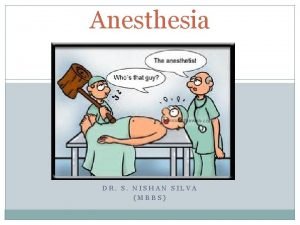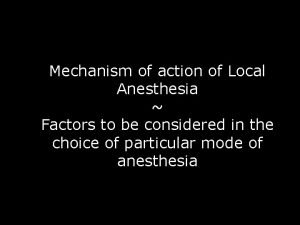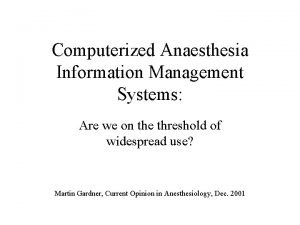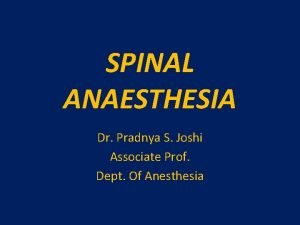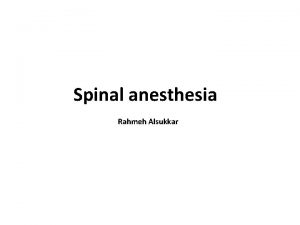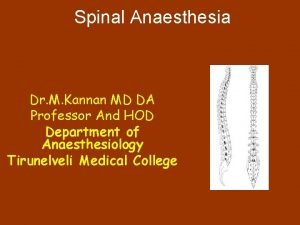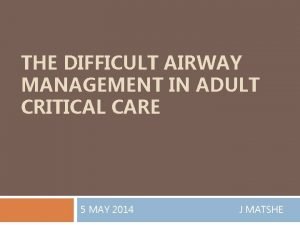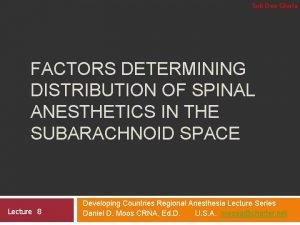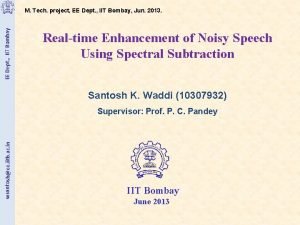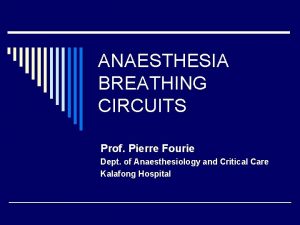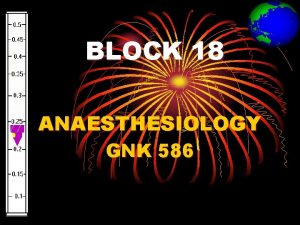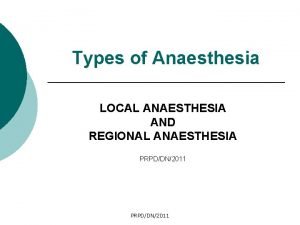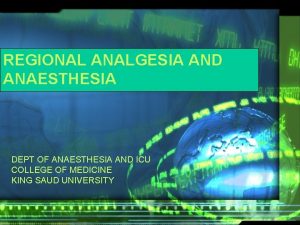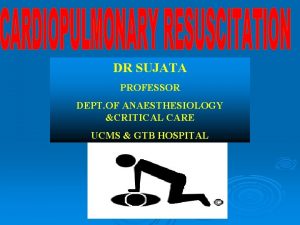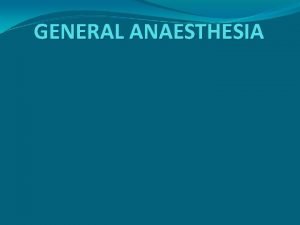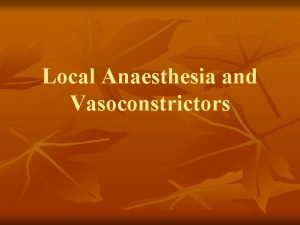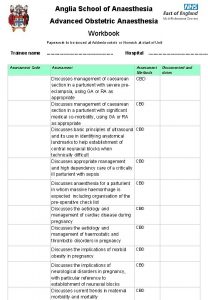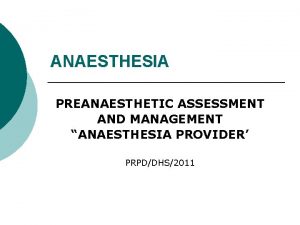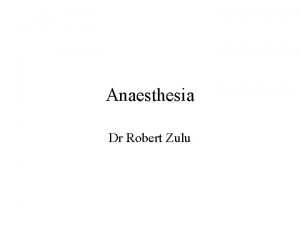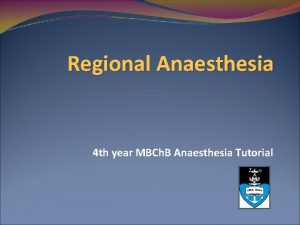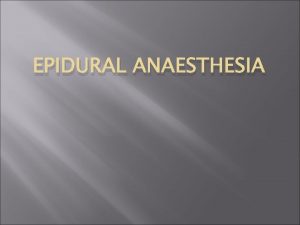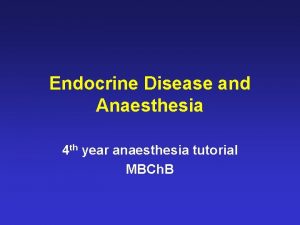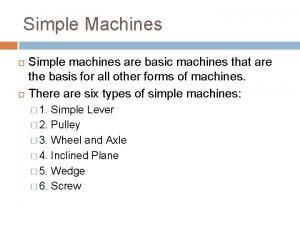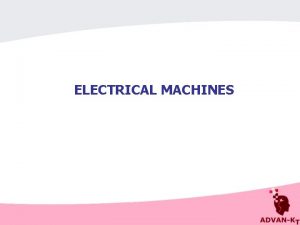ANAESTHESIA MACHINES Prof Pierre Fourie Dept of Anaesthesiology




































- Slides: 36

ANAESTHESIA MACHINES Prof. Pierre Fourie Dept. of Anaesthesiology and Critical Care Kalafong Hospital

Key Concept “Preventable anaesthetic mishaps are frequently traced to a lack of familiarity with anaesthetic equipment and a failure to check machine function” 2

FUNCTION l l l 3 l Receives anaesthetic gasses from a high-pressure supply Reduces the high pressures to ambient pressure Regulate gas flow to the anaesthetic vaporizer Delivers a precisely-known but variable gas mixture, including anesthetizing and life-sustaining gases to the fresh gas flow outlet. Gases includes oxygen, air, nitrous oxide and vapours such as halothane, isoflurane, sevoflurane or desflurane Monitoring – machine and physiological parameters

Classification l l 4 Intermittent flow machine - Drawover machine Continuous flow machine – Boyle’s machine - Anaesthesia Workstation

Drawover Anaesthesia Machine 5

Continuous flow machine l Components – – – 6 Source of compressed gas Inline filters Pressure reducing valves Fail-safe valve Oxygen flush Flow meters Oxygen analyzer Vaporizer Ventilator Breathing circuit Scavenging system

Supply of Medical Gases l Central gas bank supplies pipeline oxygen, nitrous oxide and air at 400 kpa pressure – – l l 7 Oxygen stored as a liquid at -183 o. C Nitrous oxide: Bank of large H-cylinders connected to a manifold (6000 – 8000 L) E-Cylinders (625 -700 L) attached directly to machine (1250 – 1450 kpa) Critical temperature (N 2 O = 36. 5 o. C; O 2 = 119 o. C)

Internal schematic of Anaest. Machine 8 Clinical Anesthesiology - Morgan et al, 3 rd Edition

High-pressure circuit l The high-pressure circuit consists of those parts which receive gas at cylinder pressure l l 9 hanger yoke (including filter and unidirectional valve) yoke block cylinder pressure gauge cylinder pressure regulators

Intermediate pressure circuit l The Intermediate pressure circuit receives gases at low, relatively constant pressures (400 kpa, which is pipeline pressure, or the pressure downstream of a cylinder regulator) l l l 10 pipeline inlets and pressure gauges ventilator power inlet oxygen pressure-failure device (fail-safe) and alarm oxygen and nitrous oxide second-stage regulators oxygen flush valve (35 – 70 L/min)

Low-pressure circuit l The low-pressure circuit includes components distal to the flowmeter needle valves – – 11 flowmeter tubes vaporizers check valves (if present) common gas outlet

Prevention of hypoxic gas mixture l l l l 12 Oxygen analyzer Diameter index safety system Pin index safety system International colour code Unique control knob shape Fail-safe valve Proportional device – hypoxic guard

Cylinder pin index system 13 Clinical Anesthesiology - Morgan GE et al, 3 rd Edition

International colour code 14 GAS COLOUR Oxygen White Nitrous Oxide Blue Medical Air Black and white Carbon dioxide Grey

Proportioning systems - Hypoxic Guard l l 15 Links nitrous oxide and oxygen flows (mechanically, pneumatically, or electronically) to prevent final inspired oxygen concentration of less than 25% Ohmeda Link 25: A chain links nitrous oxide and oxygen flow control knobs, allows either to be adjusted independently, yet automatically intercedes to maintain a minimum 1: 3 ratio of oxygen to nitrous oxide.

Ohmeda Link 25: Mechanical hypoxic guard 16

Flowmeters l Components – – l l l 17 Control knob Needle valve Funnel shaped glass tube Aluminum bobbin indicator (float) Specifically calibrated for each gas Flow read at top of bobbin in L/min Low flow tube in ml/min Clinical Anesthesiology - Morgan GE et al, 3 rd Edition

Flowmeters and Vaporizer block 18

Vaporizers l l l 19 Adds accurate concentrations of volatile anaesthetic agent to gas mixture Agent specific and calibrated according to vapour pressure Temperature, pressure, flow and “tilt” compensated

Plenum Vaporizers l Variable bypass – – 20 Fresh gas flow from the flowmeters enters the inlet of the vaporizer when turned on. The concentration control dial setting splits this stream into bypass gas (which does not enter the vaporizing chamber), and carrier gas (also called chamber flow, which flows over the liquid agent).

Variable-bypass Vaporizer 21 Clinical Anesthesiology - Morgan GE et al, 3 rd Edition

Ventilators l l Function – provide mechanical ventilation of lungs during anaesthesia by creating a positive pressure gradient between the upper airway and the alveoli Ventilation cycle consists of 4 phases – – 22 Inspiration, active phase - positive pressure Transitional phase between inspiration and expiration Expiration, passive phase Transitional phase between expiration and inspiration

Classification l How the tidal volume is delivered by producing gas flow along a pressure gradient. Either by – – l l Power source - compressed gas, electrical or both (bellows ventilators require both; piston ventilators do not require driving gas). Drive mechanism – Bellow ventilators are classified as doublecircuit, pneumatically driven. – – 23 Constant flow: Constant flow generator or Constant pressure: Constant pressure generator Double-circuit means that a pneumatic force compresses a bellows, which empties its contents (gas from flowmeters and vaporizer) into the patient. Driving gas is oxygen

Bellow Ventilators 24 Clinical Anesthesiology - Morgan GE et al, 3 rd Edition

Classification l Cycling mechanism – between inspiration and expiration – – – 25 time cycled – inspiratory time is set volume cycled - driving gas flow ceases when the set tidal volume is delivered (peak pressure varies). pressure cycled - driving gas flow ceases when a set pressure is reached (tidal volume varies)

Ventilators – Ohmeda 7000 26

Ventilator Alarms l l l 27 Disconnect / low circuit pressure Apnea High circuit pressure Power failure Low drive gas pressure

Anaesthesia Workstation l l l l 28 Integrated electronic anaesthesia machine CPU controlled Electronic flowmeters Electronic controlled cassette vaporizer Integrated ventilator Integrated patient monitoring Automatic record keeping

Optional extras!!! 29

Monitoring l Machine function – – – 30 Oxygen analyzer Gas flow rates Pipeline pressure Cylinder pressure Gas analyzer l Patient parameters – – Oxygenation Ventilation Circulation Body temperature

Patient monitoring – essential! l Oxygenation – – l Ventilation – – – 31 Oxygen analyzer: O 2 concentration in breathing circuit Blood oxygenation: pulse oximetry Capnography: end-tidal CO 2 Tidal volume Airway pressure

Patient monitoring l Circulation – – – l Blood pressure Pulse rate Electrocardiogram NB! Most important monitor = Anaesthesiologist 32

Anaesthesia Workstation monitor screen 33

Equipment check l l l l 34 Gas supply – correct gas and connections Backup oxygen cylinder Flowmeters Vaporizers Oxygen flush Ventilator Circuit – leaks / connections Auxiliary equipment

TAKE-HOME MESSAGE l l l 35 Check all equipment before use Never use less than 30% oxygen Always use oxygen analyzer Know your specific equipment Never leave theatre while your patient is under anaesthesia

Bibliography l l 36 Anaesthesiology – Study Guideline Clinical Anesthesiology – Morgan GE, Mikhail MS, Murray MJ and Larson CP – 3 rd Edition
 Balanced anaesthesia ppt
Balanced anaesthesia ppt Components of anaesthesia
Components of anaesthesia Calcium displacement theory of local anaesthesia
Calcium displacement theory of local anaesthesia Spinal anesthesia structures pierced
Spinal anesthesia structures pierced Anaesthesia information management system
Anaesthesia information management system Dr pradnya joshi
Dr pradnya joshi Lidocaine max dose
Lidocaine max dose Spinal anesthesia structures pierced
Spinal anesthesia structures pierced Structures pierced during spinal anaesthesia
Structures pierced during spinal anaesthesia Bullard laryngoscope
Bullard laryngoscope Blood patch
Blood patch Inhalation anesthetics
Inhalation anesthetics Contraindications of spinal anesthesia
Contraindications of spinal anesthesia Head tilt chin lift jaw thrust
Head tilt chin lift jaw thrust Florida dept of agriculture and consumer services
Florida dept of agriculture and consumer services Vaginal dept
Vaginal dept Worcester ma building department
Worcester ma building department Albany county dept of social services
Albany county dept of social services Dept of education
Dept of education Gome dept
Gome dept Maine department of agriculture conservation and forestry
Maine department of agriculture conservation and forestry Dept. name of organization (of affiliation)
Dept. name of organization (of affiliation) Affiliate disclodures
Affiliate disclodures Nebraska dept of agriculture
Nebraska dept of agriculture Dept a
Dept a Gome dept
Gome dept Dept. name of organization
Dept. name of organization Tabella nmr
Tabella nmr Dept of education
Dept of education Hoe dept
Hoe dept Employment first ohio
Employment first ohio Department of agriculture consumer services
Department of agriculture consumer services La revenue dept
La revenue dept Iit
Iit Central islip fire department
Central islip fire department Dept nmr spectroscopy
Dept nmr spectroscopy Gome dept
Gome dept

